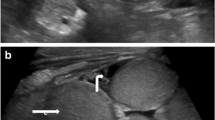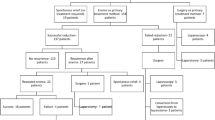Abstract
Objective
To identify predictors of failed enema reduction in children with intussusception.
Methods
PubMed and EMBASE were searched for all studies published over a 20-year time frame, prior to March 25, 2020. Original articles that reported predictors of failed enema reduction were included. The pooled odds ratio (OR) for successful enema reduction according to various features was calculated. The combined estimates were meta-analytically pooled by random-effects modeling. The risk of bias was assessed using the National Institute of Health Quality Assessment Tool. This review was registered to the PROSPERO (CRD42020190178).
Results
A total of 38 studies, comprising 40,133 cases, were included. The shorter duration of symptoms (< 24 h; combined OR, 3.812; 95% CI, 2.150–6.759) and abdominal pain (combined OR, 2.098; 95% CI, 1.405–3.133) were associated with the success (all p < 0.001). Age < 1 year (combined OR, 0.385; 95% CI, 0.166–0.893; p = 0.026), fever (combined OR, 0.519; 95% CI, 0.371–0.725; p < 0.001), rectal bleeding (combined OR, 0.252; 95% CI, 0.165–0.387; p < 0.001), and vomiting (combined OR, 0.497; 95% CI, 0.372–0.664; p < 0.001) were associated with the failed reduction. The ascites (combined OR, 0.127; 95% CI, 0.044–0.368; p = 0.001), left-sided intussusception (combined OR, 0.121; 95% CI, 0.058–0.252; p < 0.001), and trapped fluid (combined OR, 0.179; 95% CI, 0.061–0.525; p = 0.017) on US were associated with the failed reduction.
Conclusions
Successful predictors for intussusception reduction have been summarized. This evidence can help identify patients who are more likely to fail non-operative reduction and could be potential surgical candidates.
Key Points
• A shorter duration of symptoms and presence of abdominal pain were associated with increased probability of success.
• Age (less than 1 year), presence of fever, rectal bleeding, vomiting, and presence of ascites, left-sided intussusception, or trapped fluid on ultrasonography were associated with decreased probability of success.
• This study suggests that various clinical and ultrasonography predictors would help identify patients who are more likely to fail nonoperative reduction and identify potential preoperative candidates.





Similar content being viewed by others
Abbreviations
- OR:
-
Odds ratio
- US:
-
Ultrasonography
References
Waseem M, Rosenberg HK (2008) Intussusception. Pediatr Emerg Care 24:793–800
Fiegel H, Gfroerer S, Rolle U (2016) Systematic review shows that pathological lead points are important and frequent in intussusception and are not limited to infants. Acta Paediatr 105:1275–1279
Sorantin E, Lindbichler F (2004) Management of intussusception. Eur Radiol 14(Suppl 4):L146–L154
Applegate KE (2009) Intussusception in children: evidence-based diagnosis and treatment. Pediatr Radiol 39(Suppl 2):S140–S143
Blanch AJ, Perel SB, Acworth JP (2007) Paediatric intussusception: epidemiology and outcome. Emerg Med Australas 19:45–50
Fike FB, Mortellaro VE, Holcomb GW 3rd, St Peter SD (2012) Predictors of failed enema reduction in childhood intussusception. J Pediatr Surg 47:925–927
van den Ende ED, Allema JH, Hazebroek FW, Breslau PJ (2005) Success with hydrostatic reduction of intussusception in relation to duration of symptoms. Arch Dis Child 90:1071–1072
McDermott VG, Taylor T, Mackenzie S, Hendry GM (1994) Pneumatic reduction of intussusception: clinical experience and factors affecting outcome. Clin Radiol 49:30–34
Kritsaneepaiboon S, Sangkhathat S, Kanngurn S (2011) Pneumatic reduction of intussusception: factors affecting outcome in Thailand. Asian Biomed 5:235–241
Khorana J, Singhavejsakul J, Ukarapol N, Laohapensang M, Siriwongmongkol J, Patumanond J (2016) Prognostic indicators for failed nonsurgical reduction of intussusception. Ther Clin Risk Manag 12:1231–1237
Moher D, Liberati A, Tetzlaff J, Altman DG (2009) Preferred reporting items for systematic reviews and meta-analyses: the PRISMA statement. Ann Intern Med 151:264–269 w264
National Heart Lung aBI Study quality assessment tools. Available via https://www.nhlbi.nih.gov/health-topics/study-quality-assessment-tools. Accessed June 7 2020
DerSimonian R, Laird N (1986) Meta-analysis in clinical trials. Control Clin Trials 7:177–188
Higgins JP, Thompson SG, Deeks JJ, Altman DG (2003) Measuring inconsistency in meta-analyses. BMJ 327:557–560
Ogundoyin O, Lawal T, Olulana D, Atalabi O (2013) Experience with sonogram-guided hydrostatic reduction of intussusception in children in South-West Nigeria. J West Afr Coll Surg 3:76–88
Di Renzo D, Colangelo M, Lauriti G, De Girolamo F, Persico A, Lelli Chiesa P (2012) Ultrasound-guided Hartmann's solution enema: first-choice procedure for reducing idiopathic intussusception. Radiol Med 117:679–689
Fallon SC, Lopez ME, Zhang W et al (2013) Risk factors for surgery in pediatric intussusception in the era of pneumatic reduction. J Pediatr Surg 48:1032–1036
Flaum V, Schneider A, Gomes Ferreira C et al (2016) Twenty years’ experience for reduction of ileocolic intussusceptions by saline enema under sonography control. J Pediatr Surg 51:179–182
Fragoso AC, Campos M, Tavares C, Costa-Pereira A, Estevão-Costa J (2007) Pneumatic reduction of childhood intussusception. Is prediction of failure important? J Pediatr Surg 42:1504–1508
Gartner RD, Levin TL, Borenstein SH et al (2011) Interloop fluid in intussusception: what is its significance? Pediatr Radiol 41:727–731
Gondek AS, Riaza L, Cuadras D, Castellarnau XT, Krauel L (2018) Ileocolic intussusception: predicting the probability of success of ultrasound guided saline enema from clinical and sonographic data. J Pediatr Surg 53:599–604
He N, Zhang S, Ye X, Zhu X, Zhao Z, Sui X (2014) Risk factors associated with failed sonographically guided saline hydrostatic intussusception reduction in children. J Ultrasound Med 33:1669–1675
Kaiser AD, Applegate KE, Ladd AP (2007) Current success in the treatment of intussusception in children. Surgery 142:469–475 discussion 475-467
Li JE, Yang LJ, Wang J, Sheng M, Guo WL (2014) Predictors of successful air enema reduction of intussusception in infants younger than 4 months. J Pediatr Gastroenterol Nutr 58:786–788
Lim RZM, Lee T, Ng JYZ et al (2018) Factors associated with ultrasound-guided water enema reduction for pediatric intussusception in resource-limited setting: potential predictive role of thrombocytosis and anemia. J Pediatr Surg 53:2312–2317
Lui KW, Wong HF, Cheung YC et al (2001) Air enema for diagnosis and reduction of intussusception in children: clinical experience and fluoroscopy time correlation. J Pediatr Surg 36:479–481
Menke J, Kahl F (2015) Sonography-guided hydrostatic reduction of ileocolic intussusception in children: analysis of failure and success in consecutive patients presenting timely to the hospital. Eur J Pediatr 174:307–316
Mirilas P, Koumanidou C, Vakaki M, Skandalakis P, Antypas S, Kakavakis K (2001) Sonographic features indicative of hydrostatic reducibility of intestinal intussusception in infancy and early childhood. Eur Radiol 11:2576–2580
Ntoulia A, Tharakan SJ, Reid JR, Mahboubi S (2016) Failed intussusception reduction in children: correlation between radiologic, surgical, and pathologic findings. AJR Am J Roentgenol 207:424–433
Pazo A, Hill J, Losek JD (2010) Delayed repeat enema in the management of intussusception. Pediatr Emerg Care 26:640–645
Saxena AK, Höllwarth ME (2007) Factors influencing management and comparison of outcomes in paediatric intussusceptions. Acta Paediatr 96:1199–1202
Shapkina AN, Shapkin VV, Nelubov IV, Pryanishena LT (2006) Intussusception in children: 11-year experience in Vladivostok. Pediatr Surg Int 22:901–904
Shen G, Zhang C, Li J et al (2018) Risk factors for short-term recurrent intussusception and reduction failure after ultrasound-guided saline enema. Pediatr Surg Int 34:1225–1231
Simanovsky N, Hiller N, Koplewitz BZ, Eliahou R, Udassin R (2007) Is non-operative intussusception reduction effective in older children? Ten-year experience in a university affiliated medical center. Pediatr Surg Int 23:261–264
Somme S, To T, Langer JC (2006) Factors determining the need for operative reduction in children with intussusception: a population-based study. J Pediatr Surg 41:1014–1019
Takahashi T, Okazaki T, Watayo H et al (2009) Radiographic signs predictive of success of hydrostatic reduction of intussusception. Pediatr Surg Int 25:977–980
Talabi AO, Famurewa OC, Bamigbola KT, Sowande OA, Afolabi BI, Adejuyigbe O (2018) Sonographic guided hydrostatic saline enema reduction of childhood intussusception: a prospective study. BMC Emerg Med 18:46
Tota-Maharaj R, Rampersad B, Indalsingh R (2010) Barium enema reduction of intussusception in a developing country. West Indian Med J 59:535–539
Trigylidas TE, Hegenbarth MA, Patel L, Kennedy C, O'Rourke K, Kelly JC (2019) Pediatric emergency medicine point-of-care ultrasound for the diagnosis of intussusception. J Emerg Med 57:367–374
Wakjira E, Sisay S, Zember J et al (2018) Implementing ultrasound-guided hydrostatic reduction of intussusception in a low-resource country in sub-Saharan Africa: our initial experience in Ethiopia. Emerg Radiol 25:1–6
Xiaolong X, Yang W, Qi W, Yiyang Z, Bo X (2019) Risk factors for failure of hydrostatic reduction of intussusception in pediatric patients: a retrospective study. Medicine (Baltimore) 98:e13826
Avci V, Agengin K, Bilici S (2018) Ultrasound guided reduction of intussusception with saline and evaluating the factors affecting the success of the procedure. Iran J Pediatr 28:e62442
Boonsanit K, Kritsaneepaiboon S, Chiengkriwate P, Sangkhathat S (2019) Validation and modification of the ‘Chiang Mai University Intussusception scoring system’ used to predict failure of non-surgical treatment in infantile intussusception. World J Pediatr Surg 2:e000060
Venter JA, le Grange SM, Otto SF, Joubert G (2013) An audit of paediatric intussusception radiological reduction at the Bloemfontein Academic Hospital Complex, Free State, South Africa. S Afr J Child Health 7(2):60–64
Lee EH, Yang HR (2020) Nationwide population-based epidemiologic study on childhood intussusception in South Korea: emphasis on treatment and outcomes. Pediatr Gastroenterol Hepatol Nutr 23:329–345
Thanh Xuan N, Huu Son N, Huu Thien H (2020) Treatment outcome of acute intussusception in children under two years of age: a prospective cohort study. Cureus 12:e7729
Tiwari C, Shah H, Sandlas G, Bothra J (2020) Paediatric intussusception: a clinical scoring system to predict the risk of operative intervention. J Mother Child 24:19–23
Sacks RS, Anconina R, Farkas E et al (2020) Sedated ultrasound guided saline reduction (SUR) of ileocolic intussusception: 20 year experience. J Pediatr Surg 55:2009–2014
Mendez D, Caviness AC, Ma L, Macias CC (2012) The diagnostic accuracy of an abdominal radiograph with signs and symptoms of intussusception. Am J Emerg Med 30:426–431
Parashar UD, Holman RC, Cummings KC et al (2000) Trends in intussusception-associated hospitalizations and deaths among US infants. Pediatrics 106:1413–1421
del-Pozo G, Albillos JC, Tejedor D et al (1999) Intussusception in children: current concepts in diagnosis and enema reduction. Radiographics 19:299–319
Ito Y, Kusakawa I, Murata Y et al (2012) Japanese guidelines for the management of intussusception in children, 2011. Pediatr Int 54:948–958
Sadigh G, Zou KH, Razavi SA, Khan R, Applegate KE (2015) Meta-analysis of air versus liquid enema for intussusception reduction in children. AJR Am J Roentgenol 205:W542–W549
Stein-Wexler R, O'Connor R, Daldrup-Link H, Wootton-Gorges SL (2015) Current methods for reducing intussusception: survey results. Pediatr Radiol 45:667–674
Radiology ACo ACR–SPR practice parameter for the performance of pediatric fluoroscopic contrast enema examinations. Resolution 9. Available via https://www.acr.org/-/media/ACR/Files/Practice-Parameters/FluourConEnema-Ped.pdf?la=en. Accessed July 19 2020
Navarro O, Dugougeat F, Kornecki A, Shuckett B, Alton DJ, Daneman A (2000) The impact of imaging in the management of intussusception owing to pathologic lead points in children. A review of 43 cases. Pediatr Radiol 30:594–603
Hsu WL, Lee HC, Yeung CY et al (2012) Recurrent intussusception: when should surgical intervention be performed? Pediatr Neonatol 53:300–303
Funding
This study was supported by a grant (2020IE0016) from Asan Medical Center Children's Hospital (Heart Institute), Seoul, Korea, and the National Research Foundation of Korea (NRF) grant funded by the Korea government (MSIT) (No. 2020R1G1A1004591).
Author information
Authors and Affiliations
Corresponding author
Ethics declarations
Guarantor
The scientific guarantor of this publication is Hee Mang Yoon.
Conflict of interest
The authors of this manuscript declare no relationships with any companies whose products or services may be related to the subject matter of the article.
Statistics and biometry
One of the authors has significant statistical expertise on the basic statistical methods employed in this manuscript.
Informed consent
Not applicable since this was a systematic review and did not include information on human subjects.
Ethical approval
Not applicable since this was a systematic review and did not include information on human subjects.
Methodology
• systematic review
• meta-analysis
Additional information
Publisher’s note
Springer Nature remains neutral with regard to jurisdictional claims in published maps and institutional affiliations.
Supplementary Information
ESM 1
(DOCX 83 kb)
Rights and permissions
About this article
Cite this article
Kim, P.H., Hwang, J., Yoon, H.M. et al. Predictors of failed enema reduction in children with intussusception: a systematic review and meta-analysis. Eur Radiol 31, 8081–8097 (2021). https://doi.org/10.1007/s00330-021-07935-5
Received:
Revised:
Accepted:
Published:
Issue Date:
DOI: https://doi.org/10.1007/s00330-021-07935-5




